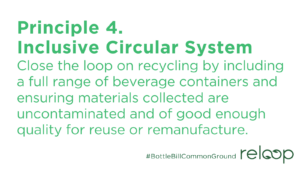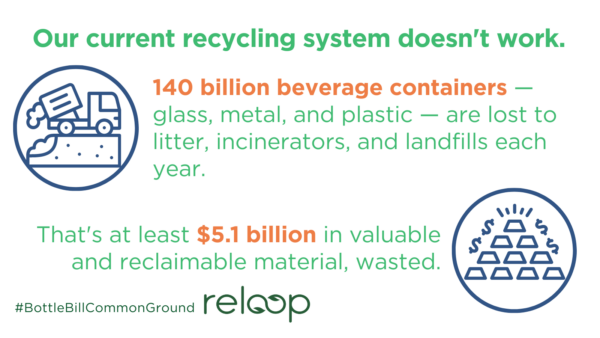Happy Thursday!
Welcome to the fourth issue of Bottle Bill Common Ground — a limited-series newsletter from Reloop North America highlighting evidence-based guidance for legislators, policy makers, industry, and advocates working on bottle bills. (If you haven’t read our first three issues, you can do so here.) This issue focuses on Principle #4 of the 10 high-performance principles for an effective deposit return system (DRS).

The driving force behind deposit return systems (DRSs) is the concept of a circular economy — which eliminates waste and pollution; circulates products and materials through reuse, repair, or remanufacture; and regenerates and enhances nature.
That’s not what happens now with most beverage containers in the U.S. At least $5.1 billion in valuable and reclaimable beverage containers — glass, metal, and plastic — are lost to litter, incinerators, and landfills each year. That amounts to 140 billion individual containers wasted. No wonder beverage containers are the number-one item littering our coastal areas.
Despite their ready recyclability, curbside recycling is falling short in this regard. When recycled in the single-stream system that U.S. municipalities have largely adopted, plastic beverage containers are considered “contaminated” by other product packaging and are no longer food-grade quality. In contrast, a DRS enables a circular system, in which bottles and cans are recycled to become bottles and cans once again.

This is where DRS comes to the rescue. Within bottle bill states, recycling rates for containers covered by bottle bill requirements are significantly higher than recycling rates for containers that are excluded. And recycling rates for included glass containers surge to more than six times higher than rates for excluded glass containers.
But to make a state’s DRS truly comprehensive, its bottle bill legislation needs to include:
-
All beverage types
-
All common beverage container material types (e.g., plastic, aluminum, glass, and polycoat containers like milk cartons)
-
The full range of beverage container volumes
An inclusive circular DRS does even more than increase container recycling rates. It also:
-
Makes the system easier to understand for consumers
-
Levels the playing field for competing beverage companies
-
Delivers economies of scale for the system operators
-
Brings dramatic reduction in overall litter for local communities
Reloop North America’s research on the impacts of DRS modernization modeled an inclusive DRS covering a full range of beverage containers in five Northeast states and found this impact:
-
Over 24.5 billion beverage containers — roughly 1.9 million tons of material — recycled each year across the five states
-
A jump from 0% recycled to 89% recycled for nips (small, single-serving liquor bottles) — equivalent to more than 70 million individual nips, one of the most commonly littered items
-
Up to 34% overall reduction in litter

Refillables are also an important part of the solution. Refillable beverage containers can be reused multiple times before being retired and recycled, reducing both waste and greenhouse gas emissions in the industry. In addition, refillable systems offer tremendous economic benefits through material cost savings and job creation, multiplied with each refill. Reloop’s research shows that implementing a deposit return system for single-use containers is a proven way to accelerate the transition to a refill economy.
Thanks for reading! We encourage you to share this newsletter widely with those who want or need to know about these principles and practices. Working together from a common ground of knowledge, we can move good bottle bills forward. Sign up here to get these blog posts as emails.
